Four Simple Stretches to Keep Your Dog Moving
Stretching exercises are so simple and swift, many people overlook the tremendous benefit they can provide. Whether your canine companion is young or old, big or small, an athlete or a lapdog, regular stretching can do wonders to keep him active and agile all the years of his life.

STORY AT-A-GLANCE
- No matter the age or lifestyle of your favorite canine companion, regular stretching sessions can significantly improve comfort, mobility and quality of life. Senior dogs … canine athletes … big breeds … and animals with chronic joint or bone disorders, in particular, can benefit from stretching, massage and maintenance chiropractic care
- Why wait until your dog is injured or in pain to take action? Natural therapies like exercise and stretching, done proactively, are among the best ways to keep your pet in good physical condition and prevent conditions that may require drugs and/or surgery down the road
- Good areas of focus for stretching your dog are the hips, shoulders, chest and back. Simple, gentle stretching exercises take just a few minutes a day to complete
- Maintaining your pet’s frame, feeding biologically appropriate nutrition, and protecting her immune system from the ravages of over-vaccination, environmental toxins, and poor quality food, are the best way to keep your four-legged family member active and healthy throughout her life
Editor's Note: This article is a reprint. It was originally published April 9, 2012.
Whether your dog is a canine athlete, getting up in years, is a large or giant breed, or just deserves some TLC (and what dog doesn’t?), stretching is a great natural tool to improve the well-being and longevity of your pet. Older dogs are prone to joint problems, loss of muscle tone and size, decreased flexibility, and the aches and pains of an aging body.
Dogs involved in athletic events — especially strenuous sports like flyball and agility — put a lot of stress on their bodies during competition. Stretching is extremely important for these canine athletes.
Large and giant breed dogs are more prone to musculoskeletal problems than smaller pets, so keeping your big guy lean, strong and supple is crucial to his well-being.
Traditional veterinary medicine doesn’t have a lot to offer these pets beyond drugs and surgery, delivered only after a problem has developed and the dog’s health and quality of life are jeopardized.
That’s why natural therapies like stretching, chiropractic, and regular physical activity are so important to maintaining your dog’s comfort, mobility and quality of life.
You might be surprised how easy it is to help your pet preserve and even increase mobility and range of motion — and decrease pain — in just a few minutes a day. The key is consistency. Providing daily walks followed by a short session of gentle stretching can do wonders for your pet both physically and mentally.
Simple, Gentle Stretches You Can Complete in Minutes a Day
There are three areas of your dog’s body for which stretching is especially beneficial — the hips, shoulders and back.
The following stretches, done slowly and gently, are well tolerated by most dogs. However, if you don’t feel confident in your ability to do the stretches, consider asking your vet or a small animal chiropractor1 to demonstrate the stretches for you so you can do them at home.
Instructions for most of these stretches have your dog standing, but you can also do them with your dog lying on her side, or in the case of the chest stretch, on her back. The model for the standing stretches, our dog Rosco, was an adult rescue who has never rolled onto his back. Some dogs are very uncomfortable in this position, so if yours is, don’t force the issue. To demonstrate the lying-on-back chest stretch, we used our dog Ada, who we’ve taught from puppyhood to ‘play’ on her back.
Needless to say, if your pet shows any sign of pain during stretching, discontinue the movement and have her seen by your vet as soon as possible.
- Stretching the hip flexors — The hip flexors are muscles that enable your dog to move his legs and hips while walking, trotting or running. To stretch the hip flexors, ask your dog to stand, and grasp a back leg above the knee. Gently and slowly move the leg back straight out behind your dog’s body. When you reach a point of resistance, where further extension will require applying pressure, hold the leg in position for 15 to 30 seconds. Repeat this stretch 2 or 3 times with each back leg.
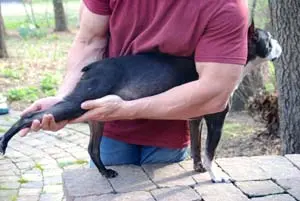
- Stretching the shoulder flexors — Shoulder flexors are muscles that allow fluid movement and proper use of your dog’s front legs. To stretch the shoulder flexors, with your dog standing, grasp a front leg above the elbow, place your other hand under the elbow to stabilize it, and gently move the leg forward (imagine you’re teaching your pet to do a ‘high-five’). At the point of resistance, hold the position for 15 to 30 seconds and repeat 2 or 3 times for each front leg.
Not only does this stretch improve the integrity of shoulder structure, it also benefits the wrists and elbows, and increases your dog’s breathing capacity by loosening her chest muscles.
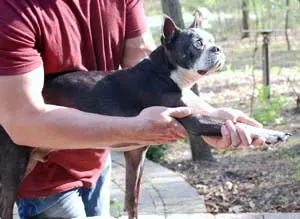
- Stretching the chest area — The muscles of your dog’s chest endure a great deal of strain. This is an abduction stretch, meaning a stretch away from center. With your dog on his back, grasp both front legs near the wrists and gently open them out to the side. Hold for several seconds, release and repeat.
Since your dog may expect a chest or tummy rub (he’s on his back, after all), you can relax him further by giving him a gentle chest massage using light pressure and circular strokes.
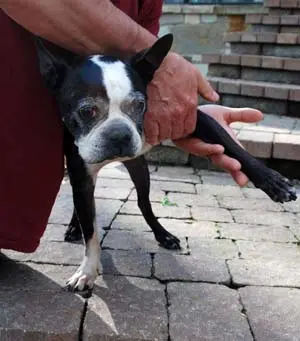
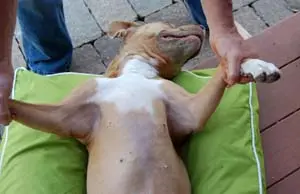
- Stretching the back — This stretch requires the use of training treats. Again with your dog standing and you on one side of her, move the treat slowly in the direction of her tail, encouraging her to follow it with her eyes – turning only her head. This will require her to bend her body into a C shape. Hold her in this position for 15 to 30 seconds, then step to her other side and repeat the exercise. Do 2 or 3 stretches on each side.
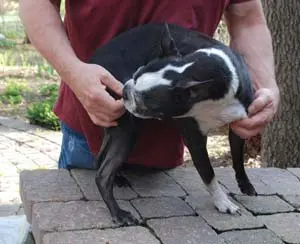
The Three Pillars of Health
Those of you who visit here often have seen me refer to the ‘three pillars of health’ in other articles and videos. These are the three primary areas of an animal’s well-being I focus on during each appointment at my Natural Pet clinic.
Maintaining your pet’s frame — keeping his body strong and his organ systems healthy — is pillar #2. Regular aerobic exercise and stretching are two of the best ways to preserve and enhance your dog’s musculoskeletal health.
Also of crucial importance are a balanced, species-appropriate diet (pillar #1) and a balanced, functional immune system (pillar #3).











